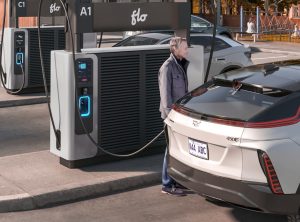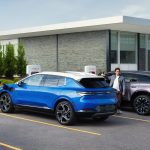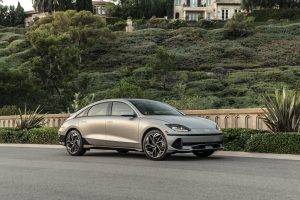During the transition to electric vehicles, the concerns of potential buyers have shifted from how far can an EV go before charging to where can we charge it? A new survey shows that EV buyers are already reliant on DC fast chargers and that demand is only going to rise.
Social media and news reports in recent months are filled with stories about electric vehicle owners struggling to take trips farther than local errands due to the unpredictability of the current fast-charging network.
Two of the biggest problems include chargers that don’t work or don’t work properly and a lack of availability of chargers — unless you own a Tesla. However, a new survey of 40,000 EV owners in the U.S. and Canada commissioned by FLO, a North American EV charging company, shows that EV owners are beginning to use fast chargers as well as home chargers.
In fact, 42% of respondents indicated they use them at least once a month and 60% reported they rely on them for extended or multi-city trips, according to the survey. The survey also highlighted what’s expected to be growing problem in the future: owners who cannot install a charger at their residence.
The survey found that 29% of EV owners in the survey did not have a charging station installed at their residence, highlighting the need for reliable public infrastructure.
Need is clear

The survey found that 29% of EV owners in the survey did not have a charging station installed at their residence.
The Biden administration has called for the installation of 500,000 public EV chargers across the U.S. by 2030. There’s roughly 20% of that figure today, though the installation rate is growing rapidly.
Last year, the number of DC fast-chargers rose by 31%, the U.S. Department of Energy reported. That’s good news for travelers who want to stop for as little time as possible — sessions typically lasting anywhere from 15 minutes to more than an hour.
By comparison, the number of Level 2 chargers rose by a more modest 13%. These 240-volt systems typically require eight hours or more to fully charge up a drained battery and are often found at hotels and other places where motorists might be spending the night.
But there’s also demand for the slower chargers at locations such as shopping centers where EV owners can “opportunity charge” to pick up a little bit extra range while running errands.
The lack of Quick chargers and Level 2 chargers is now causing backups at some locations, Power officials noted. There have been widespread anecdotal reports of EV owners having to wait an hour or more at some locations to get their turn at a charger. That’s been the case even at some Tesla Supercharger stations, according to reports.
More EV charging stories
- Public Quick Chargers Becoming More Reliable, But Still in Short Supply
- Public Charging Problems Key to Slowing Growth of EV Sales
- New Tesla Supercharger Rival Ionna Opens Up; Backed By Seven Major Automakers
Charger variety helps
While a DC fast charger is the top choice, EV owners are also comfortable using slower Level 2 stations. The survey also discovered a diverse use of charging station types, with 35% of users primarily using Level 2 stations, 27% mainly using DC fast charging stations, and 31% relying on a mix of both.

Ionna, a new charging company is a joint venture launched by seven major automakers. It will install plugs for both CCS and NACS.
This variety underscores the need for a comprehensive network that offers both quick top-ups and longer-stay charging solutions and is designed for drivers who live in a range of building types. The study also found that when owners charge a vehicle 51% use nearby amenities, whether that’s going into a grocery store or coffee shop.
Those were the top two choices for owners who were charging their vehicles: 60% of drivers said they use this time to eat or buy refreshments while 19% said they use nearby retail stores to shop.
“FLO’s survey demonstrates the need for more robust charging solutions across North America, enabling drivers to plug in wherever they are — at work, home, or on the go.” said Louis Tremblay, president and CEO of FLO, which is in the process of expanding its network of FLO Ultra chargers, capable of 320 kW of power now, but can ultimately provide 500 kW once more vehicles are capable of accommodating the power.








0 Comments